

Designing Permaculture Plant Guilds by Toby Hemenway on Prezi. Arbornaut Nursery - Arbornaut Nursery. Saskatoon Berries - Prairie Plant Systems Inc. PPS offers a number of varieties of Saskatoons.
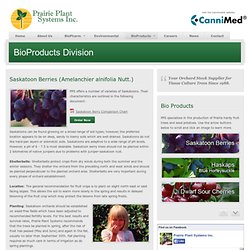
Their characteristics are outlined in the following document: Saskatoon Berry Comparison Chart Order Now Saskatoons can be found growing on a broad range of soil types; however, the preferred location appears to be on deep, sandy to loamy soils which are well drained. Saskatoons do not like hard-pan layers or solonetzic soils. Saskatoons are adaptive to a wide range of pH levels. Shelterbelts: Shelterbelts protect crops from dry winds during both the summer and the winter seasons. Gooseberries. Gooseberries Many North Americans are probably not familiar with gooseberries, a relative of the currant; but they are very popular in Great Britain where they are used to make jams, jellies and are eaten fresh.

Most of the gooseberry propagators seem to be "across the pond," so PrairieTech is pleased to offer four gooseberry cultivars suitable for growing in our area. Cultivars Hinnomaki Red & Yellow The Hinnomaki cultivars from Finland are sweet and flavourful. Invicta Invicta is considered by some to be the best gooseberry available in North America. Jahn's Prairie This cultivar is an Alberta native! L'hamamélis de Virginie dans le traitement des problèmes de peau. Pépinière Casse-Noisette - Arbres rares. Hamamélis de Virginie, (Hamamelis virginana) Petit arbre ou arbuste à tiges multiples, à feuilles décidues, haut de 1 à 5 m, à écorce lisse, brune, mince et écailleuse et à branches nombreuses, longues, souples et ramifiées changeant de direction au niveau des noeuds.
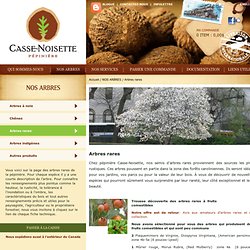
Selon certains botanistes, cette configuration en zigzag sert à étaler le feuillage et à capter le maximum de lumière malgré l'ombre des arbres plus grands car il est parfaitement adapté à l'ombre. Les feuilles, qui ressemblent à celles des noisetiers (Corylus spp.), mesurent 5 à 15 cm de longueur et ont un bord ondulé ou festonné et une base asymétrique.
Le système racinaire est souvent peu profond. Chez les sujets les mieux développés, le diamètre du tronc peut atteindre 10 cm, ou même dans de rares cas 30 cm. L'hamamélis a cette propriété particulière de fleurir tard en automne, souvent après les premières gelées. Microsoft Word - plaqueminier.doc - 20130218163907_plaqueminier.pdf. Microsoft Word - chene_gros_fruits.doc - 20130214141412_chene_gros_fruits.pdf. Microsoft Word - chene_bicolore.doc - 20130214135334_chene_bicolore.pdf. Microsoft Word - chene_blanc.doc - 20130218142328_chene_blanc.pdf. Microsoft Word - pin_siberie.doc - 20130220105936_pin_siberie.pdf. (Microsoft Word - pin_cor\351e.doc) - 20130215160349_pin_core.pdf. Pépinière Casse-Noisette - Arbres à noix. Noyer noir, Juglans nigra variété ''Ottawa''' (Black Walnut) Grand arbres très prisé pour la valeur de son bois et de ses noix savoureuses au goût riche et unique ses noix sont fortes en éléments nutritifs.
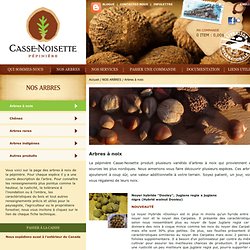
Le noyer noir est l’arbre tout indiqué pour vos plantations en verger à noix, en enrichissement de boisé, pour planter sur votre grand terrain résidentiel et enfin en plantation serrée pour la production de billes de qualité pour l’industrie du bois d’ébénisterie. CPNCQ - Offre. CPNCQ - Home. Territorial Seed Vegetable Garden Planner. Specialty Onions - Yellow Multiplier Onion. Allium cepa, Aggregatum Group: Multiplier onions, also known as potato onions, form a cluster of underground bulbs from each single bulb planted.
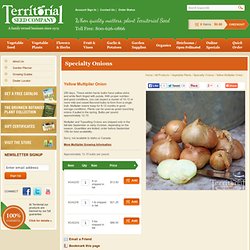
Once established in your garden, multiplier onions will improve in size and quality, and their bulbs can be replanted year after year. A great food source for the self-sufficient.CULTURE: Plant multiplier onions in the fall as you would garlic. Plant individual bulbs 6 inches apart in the row and at a depth that allows the very tip of the bulb to lie even with the surface of the soil. A few inches of mulch or compost spread over the bulbs completes your planting. The following spring the onion will send up leaves. Topsetting and Multiplier Onions are shipped only in the fall-late September or early October, depending on the season.
Sorry, not available to Idaho or Canada. The Far North Garden: mushrooms. Oyster mushrooms can grow easily in cold climates, and freshly gathered mushrooms are generally superior in flavour and shelf-life to those "gathered" from your local produce section.

For those of us who can't or don't gather mushrooms in the wild, they can be cultivated in a shady place in your own garden. This could be a good solution for an area in a yard where there are not enough hours of sunlight for any other food crop.
Thyme to Transplant Between the Flagstones. It was a beautiful day today, was it not?

We woke up at 7 Saturday morning to go down to the Round Rock Farmer’s Market, where we picked up some beautiful carrots, a couple of loaves of tasty homemade bread (one was pumpkin, and the other was cracked pepper and Parmesan) and some homemade natural soaps. On the fly, my mother-in-law, wife and I headed on down to Round Rock Gardens, a local nursery off of Sam Bass near southbound I-35.
It’s funny, but I was thinking as I approached the gates to the nursery that I was just as excited about looking at plants than I used to be going places like Best Buy. I spend less time playing with gadgets these days, which is good. I spend time in front of the computer researching, writing and working, but I mostly just love to be out among my plants. Visiting a nursery, however, is now just as bad as visiting Best Buy used to be.
Microsoft Word - Guild 2005.03.doc - Permaculture-Guild-2005-03.pdf. Specialty Cropportunitites. Other Common Names Include: Siberian pineapple, Sea Berry, Sandthorn or Swallowthorn Latin Name: Hippophae rhamnoides L.

Plant Family: Elaeagnaceae Close Relatives: None Uses and Markets: Culinary (juices, teas, fresh and frozen fruit); medicinal (fruit and oils used for the treatment of internal and topical maladies); personal care products; essential oil Production Life Cycle in Ontario Perennial Hardiness Zone Special Notes A woody shrub to small tree with an extensive root system capable of fixing nitrogen. Propagation method Most commonly by transplants from cuttings, less commonly by root divisions and seeds Greenhouse Seeding/Propagation Dates Autumn or winter (seeds and cuttings). Field Seeding Date: Field Transplanting Dates Spring. Promo-Cultures: Noisetier. La culture de l'aronia au Québec... un aperçu! - Aronia. Horoscope 2014. Gooseberry Bush Care. An ideal fruit for the small garden - gooseberry bushes are easy to grow, produce a large amount of fruit for their size and will tolerate partial shade conditions.
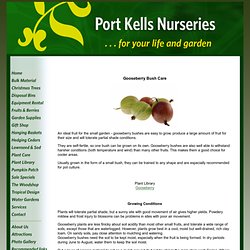
They are self-fertile, so one bush can be grown on its own. Gooseberry bushes are also well able to withstand harsher conditions (both temperature and wind) than many other fruits. This makes them a good choice for cooler areas. Usually grown in the form of a small bush, they can be trained to any shape and are especially recommended for pot culture. Plant Library Gooseberry Growing Conditions Plants will tolerate partial shade, but a sunny site with good movement of air gives higher yields. Gooseberry plants are less finicky about soil acidity than most other small fruits, and tolerate a wide range of soils, except those that are waterlogged.
Dang-labyrinth-herbs1.